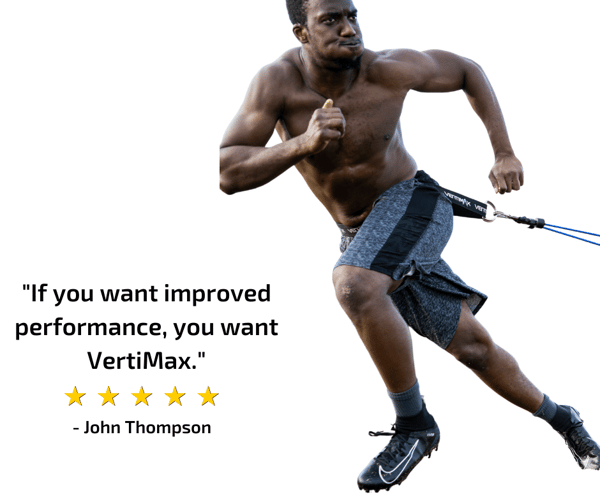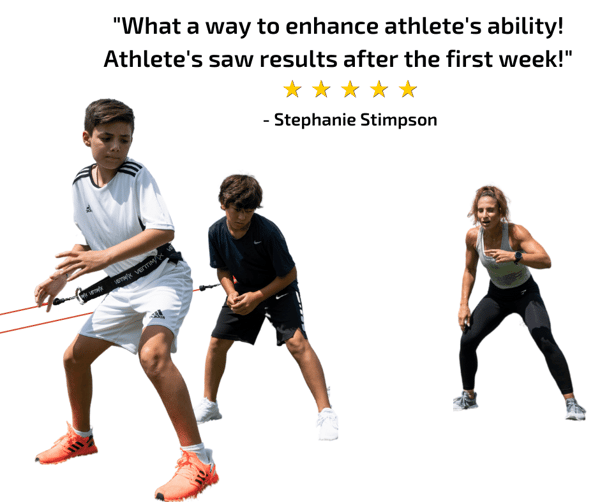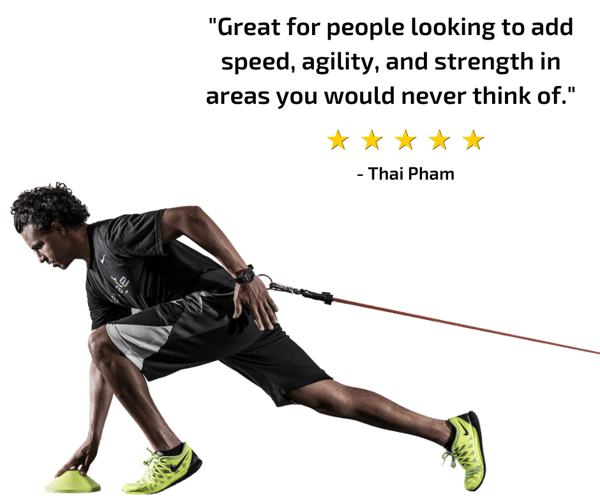VertiMax Raptor and V8 platform technology offer a more effective way of modifying and improving neuromuscular function so athletes of any age can develop superior agility performance. Athletes can maximize neuromuscular control and reactive power potential with VertiMax Platforms and Raptors.
The ability to rapidly decelerate, change direction and rapidly accelerate again with stability is called agility. In athletics, there are few performance parameters that can have a more profound effect on performance than agility in any ground-based sport. Effectively developing an athlete’s full agility potential at any age and for any sport is essential, but often difficult to achieve. That’s where VertiMax steps in.

Agility training is the cognitive and muscular ability to change direction in response to a stimulus with varying degrees of speeds. This distinction is critically important: agility involves an equal demand on your muscular system as well as your central nervous system. Your muscles, mind, nerves, and cells must all work together to master speed, turns, direction changes, and overall agility.
Agility can be divided among equally important components including perception, decision-making, and change of direction speed. Sounds simple on paper right? You just have to decide to turn here, move slower, or go there. But it’s easy to forget that these decisions must be made so quickly that it is actually an instinct; there’s no time for internal debate.
Agility training teaches your body how to react instantaneously when presented with a sudden change in stimulus, such as a charging linebacker who can easily hit you so hard you’re out for the game.
Perception and decision-making abilities are learned, sport-specific tasks contingent on the skill level and practice of an athlete. Change of direction speed requires multi-level coordination of various skills that can be trained independently of agility specific tasks to crossover into improved agility. The motor skills gained during agility training are a complex association among the supra-spinal, spinal, and physiological level of the neuromuscular system.

Training for agility must involve drills that train the various levels among change of direction speed. The training prescribed must involve an assessment of the athlete to ensure the program is effective for the sport and position of the athlete. Therefore, training for multi-directional speed with the use of quickness, reaction time, and straight sprint ability, should be the primary focus of the program. However, incorporating resistance, strength, stability, plyometric, and flexibility exercises would be advantageous for the overall performance of the athlete.
Any athlete can benefit from agility training. Whether you’re a pro, amateur, or a weekend warrior, agility training can have a tremendously positive impact in your athletic performance as well as your day-to-day health.
The VertiMax consistent resistance band technology used in the Raptor and V8 platform training systems change the way elastic bands work by eliminating radical increases and decreases in resistance as elastic bands are stretched or shortened for distances of up to 40 yards. Used by professional teams in every major sport, the VertiMax technology is a game-changer when it comes to radically improving agility for some very important reasons.
Athletes can continue accelerating for longer distances and achieve higher resisted training velocities which leads to increased speed strength. Increased speed-strength means athletes will be able to create the additional force necessary to decelerate and perform rapid acceleration to separate from other players and make competitive moves at much higher velocities.
VertiMax provides a superior training by loading on the horizontal plane to develop dynamic, multi-planar (3D) stability which is a critical foundation for supporting agility performance.
Imagine performing an agility drill at any velocity over distances of up to 40 yards with non-varying resistance constantly applied to your waist and acting horizontally from any angle. Every time your foot strikes the ground your neurology interacting with your muscles must compensate for that applied load to maintain balance and lateral stability during dynamic movement. The adaptive training response from this stimulus is nothing short of amazing as one’s neuromuscular control time to correct spontaneous disruptions in balance will be elevated far beyond normal in addition to improving strength and power for improved agility. That’s how you create a superior athlete!
The Raptor and V8 system’s ability to load both legs simultaneously while in the ground and non-ground contact positions . As athletes adapt to training with both legs individually loaded, their ability to generate the force on the horizontal plane for acceleration and deceleration purposes will be greatly enhanced. Ankle and knee attachments allow you to load the foot and leg as it moves through the air to uniquely develop strength in the recovery phase of leg movement. Meanwhile, the stabilizing muscles in the opposite foot and leg that are in contact with the ground will activate subconsciously to stabilize and balance the athlete against the load pulling on the opposite airborne foot and leg. VertiMax Raptor and V8 products allow you to train strength, power, balance and muscle motor control simultaneously on 3 axes! This is an unparalleled advantage for agility development in athletes of all ages.
The VertiMax Raptor is a great speed training device for maximizing top end speed. The Raptor is a very lightweight portable resistance training device that will allow athletes to train on the go. Unlike any other training systems on the market, the raptor only weighs fifteen pounds, so it's very easy to use inside as well as take it to a field or a track. Because it can be easily attached to a fence the Raptor provides a mobile training solution for teams and individuals. Watch the video Vertimax Rapor EX Speed and Agility Training Equipment.
Have you ever watched a basketball or soccer game where a player was close to scoring only to be surrounded by the opposing team? Suddenly, he spins, ducks, and side-steps to put the ball exactly where it needs to go, the goal. No one saw his reaction coming, and few realize what happened until it’s too late. How was one player able to dodge through several members of the defense to score? What gives the edge to players in every type of sport whether that is football, martial arts, or hockey? The answer is simple, it’s all about agility.
It’s a skill like any other sports skill that has to be learned through constant practice and repetition. Agility allows you to speed up, slow down, and suddenly change direction all while keeping balance and perfect control of your body. The importance of agility cannot be overstated. Agility can determine the outcome of a game in the same way knowing how to throw a perfect spiral into an end zone will.
Agility training for athletes hasn’t always been such a hot topic in the world of sports. It’s only been in the last few decades that sports have taken advantage of science and technology. What was once running across a field now involves perfectly-timed running drills, fitness technology that applies resistance to improve side sprints, and nutrition that amplifies recovery and results.
In other words, this is the best time in history to train yourself or your team to become more agile because we have the knowledge, technology, and supplementation to ensure maximum results.

Agility is relevant to nearly every sport because it involves a period of deceleration, change of direction, and acceleration. Changing direction in a sport is a reaction to an external stimulus such as avoiding a collision, evading another player, and remaining within the area of play.
Athletes train for agility because it is a key component for achievement in sport. An athlete’s ability to be the fastest on the field, court, or ice is only a small part of their success because other factors such as agility, strength, power, and decision making play a crucial role. Training for agility is a multifaceted approach because it includes physical, mechanical and cognitive adaptations to take place. Additionally, an athlete must train various skills such as strength, power, and speed to optimize their agility during sport.
Take soccer players for example: These players must run up and down an entire field while simultaneously guiding a ball with their feet and avoiding their opponents (who have no issue with kicking shins). Think you can simply run in a straight line from one end of the field to the next? Think again. Agility training for soccer players is a requirement as every player must know when to run, stop, pass, turn, side step, block, and shoot. This isn’t a sport where you’re good at one thing, you have to be the best at everything. This is why agility training is so important. Check out the Top Benefits of Agility Training for Athletes.
When you train to improve your agility, you will be placing a high-level demand on your body mechanics, neurological system, and muscular system. The foundation of agility training focuses on developing two primary skills: perception for decision making as well as change of direction speed. In other words, you will learn to perceive a change in stimuli and in response, change direction while maintaining an appropriate speed.
Perception for decision making includes visual scanning, anticipation, pattern recognition, and sport specific knowledge of the situations. In contrast, change of direction speed includes foot placement, transfer of energy, and maintenance of body position. How does VertiMax work? Take a look at what the VertiMax Science and Research says about VertiMax training. .
The VertiMax Raptor system delivers constant resistance that allows coaches to perform multi-directional speed, agility training, and more. The Raptor device is completely unique and very different from other elastic resistance tools because it keeps resistance tension the same over the entire distance traveled, as compared to traditional resistance bands where tension increases exponentially as the athlete travels farther. The Raptor EX product, as with the VertiMax platform EX, enables extended range training of up to 40 yards which makes the equipment even more capable for drills at longer distances.
Agility training can be broken down into 6 major components.
See our blog post 8 Best Agility Training Exercises to learn more. These will help improve speed, explosive power, coordination, and specific sports skills. From high school to professional sports teams, all athletes can benefit from agility training exercises.
According to the National Strength and Conditioning Association, agility training can begin at the age of five. However, drills will be very different than when the child becomes a teenage and still different when the teen is an adult. Also check out the Best Youth Agility Training Workouts. Here’s a breakdown of age ranges and appropriate agility training techniques.
Agility training is ideal for all athletes and encouraged for almost every sport. Here are a few ways to apply agility training in any sports setting.
Agility training involves an equal demand on the mind and body as both must work together in order to accelerate, decelerate, change direction, and respond appropriately to any given stimulus. The proven benefits of agility training go outside the world of sports and also apply to the general public. Non-athletes can enjoy a greater level of fitness including more lean muscle tissue, less fat, more strength, and greater endurance. On a functional level, both athletes and non-athletes can establish an elite level of neuromuscular connections while significantly decreasing their risk for injury.
For athletes, agility training is a necessity. It is the training that can give you a clear advantage in your sport and on the field of play. For non-athletes, one or two weekly sessions of agility training is recommended to enhance your results.